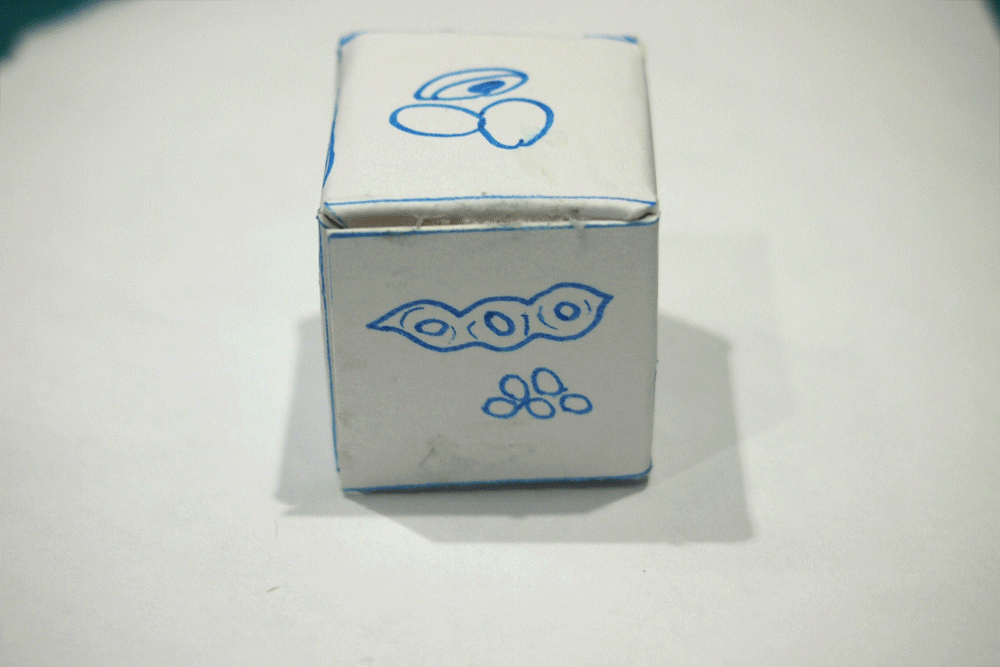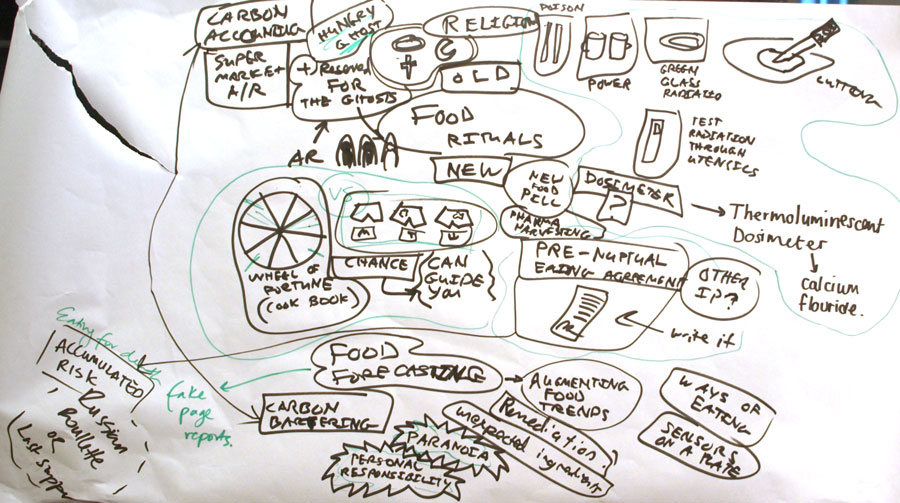
The three groups that formed on the first day continued where they left off in the morning of day two, with the goal of creating a very basic prototype by the end of the day. A group of 12 NUS undergraduate students joined us for the second half of the day. Denisa took them through a brainstorming exercise to think about extreme scenarios for eating during the anthropocene, and then they split into groups of three to work on different projects: food forecasting, future imaging and hunting for unusual ingredients.
NEW FOOD RITUALS
There were no chemists on the team, so finding simple testing methods for mercury or pesticides proved difficult. However, the team uncovered a number of easy ways to create DIY ‘pH paper’, or even liquid. An overview of different methods was found here.
Deciding to try the Red Cabbage method, where alkaline changes the paper to green; acids to red, we brainstormed various applications for this pH detector. What pH do different foods have? What does it mean to eat an acidic diet or an alkaline diet? How would knowing the pH of your food affect your eating habits?
From dipping pieces of food into the pH cabbage water, to soaking wooden chopsticks in it to make them pH sensative, eventually we decided to try and create a pH sensitive tablecloth. Given time constraints and lack of ingredients, this was not completed in time on day two, but distilled water is currently being infused by red cabbage in order to have a prototype ready for tomorrow’s symposium.

Jaz and Cat looking for methods to make pH paper and red cabbage soaking.
CHANCE-BASED EATING HABITS
After going through a number of possible interface designs (wheel of chance, strong man fair-ground scale, pinwheel) we settled on prototyping a dice, because a working prototype could be made quickly, and it is easily transported and replicable.

Dice drawings by Jodi Newcombe
The dice could be used at an event such as the Massivley Multiplayer Carbon Reduction Dinner Competition which is like a playing card game where you eat as well. Each diner is a player, and rolls the dice at the start of the course (amuse bouche, salad, appetizer, main course, side dish, desert). Each dice roll determines which version of the course they will get. Different versions have different ingredients and different carbon loads. Every player gets one chance to re-roll during the game, and there only limited numbers of each kind of plate. The last one to roll gets stuck with whatever is left, and the order of the dice rolls changes each turn. The eater with the lowest carbon count at the end of the meal wins! (And everyone hopefully has a good time leaving the complicated ethics of carbon accounted food up to the roll of the dice).
The idea of chance continues to be an interesting and unexplored technique for changing behavior, and removing information overload around personal environmental choices.
DINING WITH BIG DATA
 Figuring out the Makey Makey and recording Big Data audio
Figuring out the Makey Makey and recording Big Data audio
This group got started the morning off by discussing ways for the prototype to manifest itself. Using a makey makey as a prototyping tool, they decided to create an interaction between a human eater and an avacado. When the eater cuts into the avacado, it triggers audio that either tells you good or bad big data health consequences related to eating avacados. The audio was developed as a script of the ‘good angel’ and the ‘devil’ as a classic symbol of the mind wrestling with morals, desires, and consquences, but in this case a battle of the good data vs the bad data. In addition, this interaction happened in front of a computer with a webcam so the eater sees herself reflected. As the avacado is sliced and diced an angel or a devil appears on the eater’s shoulder depending on what audio is triggered.

FOOD FORECASTING

This was an additional excerise with the group of undergraduate students. Taking inspiration from trend forecasting practices, this exercise was devised to imagine what a food forecasting practice might be like. The Center has long considered how certain ingredients go from being somewhat fringe to being ubiquitous in supermarkets and at restauraunts. For example, the rise of pomegranetes and black garlic in Western cuisine. Is it linked to scientific discoveries? Celebrety chef recipe books? We wonder: can food forecasting be used to create meaningful changes in the food system, or simply new fads?
The students were divided into teams and had to imagine what food trends might emerge in the future. Zack played the Boss of a food forecasting company and the teams were working for him. At the end of the exercise, the two teams presented their food forecasting ideas to a panel of judges that decided which trends to take forward.
 Presentation to the panel of judges
Presentation to the panel of judges
Day 2 allowed us to refine our initial ideas, and create some simple prototypes. At least a few of these ideas will be carried on in our research over the coming months, and it was a treat to engage with so many different thinkers and makers.


















